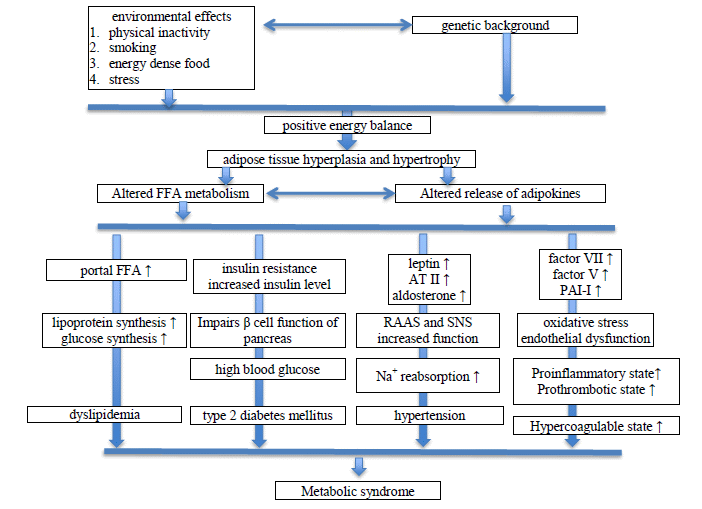XII. Treatment of the metabolic syndrome
It is clear that the MetS develops as a result of a very complicated system of physiological changes that interlock on multiple levels (Fig. 33).

Figure 33. Outline of the development of the MetS
(FFA = free fatty acid; ATII = angiotensin II; PAI-1 = plasminogen activator inhibitor-1; RAAS = renin-angiotensin-aldosterone system; SNS = sympathetic nervous system;
Jaspinder Caur: A Comprehensive review on metabolic syndrome, Cardiology Research and Practice; Volume 2014 article ID: 943162 Hindawi Publishing Corporation)
In practice, the patient will meet the doctor for the first time in connection with only one of the organ symptoms (Table 11).
|
Organ |
Symptoms |
|
Kidneys |
microalbuminuria, filtration dysfunction (hypo- or hyperfunction), sclerosis, chronic renal failure |
|
Liver |
ALT ↑, NAFLD, NASH, |
|
Skin |
acne, blackhead, acanthosis nigricans, inflammation of the subcutaneous adipose tissue (lupus erythematosus), insulin resistance after a burn, psoriasis, androgen (dihydrotestosterone)-caused hair loss (androgenetic alopecia), skin cancer |
|
Eyes |
nondiabetes-caused retinopathy, clouding of the lens (cataract), retinal artery obstruction, glaucoma, paralysis of eye-moving muscle |
|
Sleep |
obstructive sleep apnoe (OSA) |
|
Reproductive system |
gonad hypofunction, polycystic ovary syndrome (PCOS), erectile dysfunction |
|
Circulatory system |
hypertension, coronary heart disease (CHD), heart infarct, stroke |
|
Lungs |
tumor |
|
Pancreas |
tumor |
|
Prostate |
tumor |
Table 11. Systemic effects of the metabolic syndrome
(ALT = alanine aminotransferase, NAFDL = non-alcoholic fatty liver disease, NASH = nonalcoholic steatohepatitis
Jaspinder Caur: A Comprehensive review on metabolic syndrome, Cardiology Research and Practice; Volume 2014 article ID: 943162 Hindawi Publishing Corporation)
After detection of the MetS criteria, the following treatment possibilities are available: